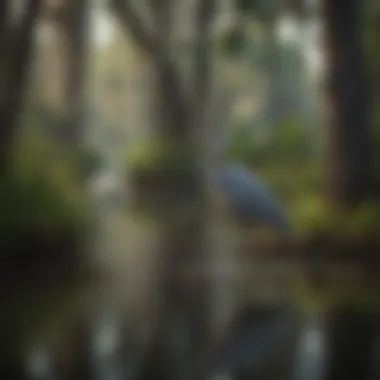Exploring Florida's Natural Resources and Conservation


Nature Topic Overview
Understanding nature and conservation in Florida is essential for young learners. Florida is home to a wide variety of species and ecosystems, from the Everglades' marshlands to coral reefs in the surrounding waters. These unique environments are rich in biodiversity, providing invaluable resources and contributing to our planet's health.
The relevance of exploring Florida’s natural resources goes beyond simple observation. It opens up discussions about how our activities impact these natural systems. When children learn about their local environment, they develop a sense of respect and responsibility toward nature.
Fun Facts and Trivia
Here are some fun facts about Florida's natural resources to spark interest:
- Florida has more than 1,300 species of native plants.
- The state is known for its extensive wetlands, which help clean water and provide habitat.
- Over 60 different mammals can be found in the diverse environments of Florida.
Engaging visuals and interactive activities can foster curiosity about these facts. Consider using educational infographics that showcase the variety of native wildlife.
Wildlife Explorations
In Florida, one encounters diverse species like the endangered Florida manatee, the elegant bottlenose dolphin, and the majestic bald eagle. Each of these animals has a role in their ecosystem.
Key Species to Discover:
- Florida Manatee: Known for their gentle nature, they groom aquatic plants throughout waterways.
- Bottlenose Dolphin: Intelligent creatures, often seen in pods throughout the coastal areas.
- Bald Eagle: America's bird, known for its striking appearance and keen hunting skills.
Children may find it thrilling to take part in quizzes or puzzles about these wildlife species, learning while having fun.
Environmental Awareness
Conservation and sustainability practices are crucial to maintain Florida’s ecosystems. Whether through planting native trees or participating in beach cleanups, children can take steps to protect nature.
Tips to Help Protect Nature:
- Reduce, Reuse, Recycle at home.
- Learn about and plant native flowers and plants.
- Attend local environmental programs.
Prolusion to Florida's Natural Resources
Understanding Florida's natural resources is crucial for several reasons. These resources provide not only the foundation for local ecosystems, but also support tourism, agriculture, and overall quality of life. In this article, we will explore the significance and variety of these natural resources and highlight the imperatives that call for their sustainability.
Defining Natural Resources
Natural resources refer to materials or substances that occur in nature and can be utilized for economic gain or ecological benefit. In Florida, these include the state's rich sunlight, lush forests, diverse wildlife, and vast waterways. The bounty of resources offers numerous opportunities for exploration and learning.
The definition of natural resources is wide; they can be categorized into many types, ranging from renewable resources like solar heat to non-renewable resources such as minerals. Understanding what these resources are and where they come from fuels children's curiosity about their environment.
Importance of Natural Resources
Natural resources in Florida are not just commodities; their importance is multifactorial. They play an essential role in local economies, providing jobs through industries like tourism and agriculture. They also support cultural and recreational activities, thus enriching community life.
Moreover, these resources sustain the diverse ecosystems that call Florida home. Biodiversity can contribute significantly to ecological health, ensuring that air and water quality are maintained. Protecting and conserving these resources is therefore critical, as their depletion might have dire consequences not just for humans, but for all living organisms that rely on these natural systems.
Overview of Florida's Ecosystems
Florida's ecosystems form a crucial part of the state's identity. They provide numerous benefits, from supporting biodiversity to sequestering carbon. Understanding these ecosystems aids in making informed decisions about conservation and utilization of natural resources. Many of Florida's ecosystems, like coastal habitats and wetlands, face threats, making awareness essential for their protection.
Coastal Ecosystems
Coastal ecosystems represent the transition zone between land and ocean. They serve several critical roles in the health of the environment, and they are home to diverse species. This article highlights three main components of Florida’s coastal ecosystems: beaches and dunes, estuaries, and coral reefs.
Beaches and Dunes
Beaches and dunes provide significant habitat for a variety of marine and terrestrial life. These sandy areas act as natural barriers against strong waves, protecting coastal areas. The key characterics of beaches includ their role in storm protection and supporting endangered species like sea turtles.
A unique feature of beaches in Florida is their seasonal shifts, influenced by storms and tides. While they are resilient, constant human activity can lead to erosion and habitat loss. Protecting beaches ensures that these ecosystems continue to support both wildlife and human recreation.
Estuaries
Estuaries are where freshwater from rivers meets the saltwater of the ocean. This mixture of waters creates nutrient-rich habitats. They are vital for many aquatic species, acting as nurseries for fish that later inhabit oceans.
Estuaries in Florida, such as the Indian River Lagoon, support extensive biodiversity. They host numerous species and serve as important stopover sites for migratory birds. However, activities like pollution and development threaten these areas. Maintaining healthy estuaries is essential for maintaining environmental integrity.
Coral Reefs
Coral reefs are often referred to as the "rainforests of the sea" due to their rich biodiversity. They contribute significantly to Florida's tourism industry, drawing divers and snorkeling enthusiasts. Coral reefs offer coastline protection and habitat for fish.
A unique challenge faced by coral reefs is their sensitivity to climate change. Rising ocean temperatures lead to coral bleaching, compromising their health. Conservation measures are critical for their survival, and educating about their significance can foster community involvement in protecting these valuable ecosystems.


Wetlands
Wetlands are areas where water covers the soil for part of the year. They play a key role in water filtration, flood control, and provide habitat for numerous species. This section discusses swamps, marshes, and floodplains, all vital components of Florida's wetlands.
Swamps
Swamps are a type of wetland, characterized by the presence of woody plants. They support unique ecosystems and act as effective filters for pollutants. The main characteristic of swamps is their ability to retain water that helps lessen flooding risks.
Many species find their homes in Florida's swamps, like alligators and wading birds. However, swamps are often targeted for development. This approach can lead to considerable environmental damage, emphasizing the need for awareness and conservation efforts.
Marshes
Marshes are dominated by herbaceous plants and are often found near rivers and lakes. They are important for water purification and provide essential habitats for birds and aquatic life. Marshes help reduce flooding and improve water quality, making them integral to hydrology.
Historically, marshes have faced the threat of drainage and conversion to agriculture. Actions to protect them preserve biodiversity and critical ecosystem services essential for Floridian life.
Floodplains
Floodplains are flat lands beside rivers and streams that flood during heavy rain. They support a wide range of vegetation and wildlife. An essential feature of floodplains is their role in water storage, which helps mitigate flood risks.
Floodplain ecosystems help recharge groundwater and maintain healthy rivers. Conserving these areas is critical for managing resources effectively and curbing adverse impacts of floods.
Forests and Woodlands
Florida's forests and woodlands are key to maintaining ecological health and biodiversity. They sequester carbon, influence climate, and provide habitats for countless species. Understanding these ecosystems reveals their importance.
Longleaf Pine Forests
Longleaf pine forests are unique ecosystems home to diverse plant and animal species. These ecosystems are associated with fire, a natural process that promotes biodiversity. Longleaf pine forests support critically endangered species, such as the red-cockaded woodpecker.
However, only a fraction of these forests remain today due to logging and development. Restoration efforts are essential to effectively preserve biodiversity and foster ecosystem resilience.
Hardwood Swamps
Hardwood swamps are characterized by hardwood tree species that can tolerate flooded conditions. They are biodiversity hotspots and provide critical habitat for unique flora and fauna. The retention of water in these swamps is paramount for the health of groundwater systems.
Human interventions often result in damaging these ecosystems, making it crucial to educate the public on their importance. Conserving hardwood swamps helps to retain ecological balance.
Sand Pine Scrub
Sand pine scrub is a unique ecosystem found in Florida. Named for the prevalent sand pine, this area holds numerous plants and animals adapted to sandy soils and fire conditions. A key characteristic of this ecosystem is its role in species conservation and habitat restoration.
While it is ecologically significant, sand pine scrub faces threats from urban expansion. Awareness and protective measures are vital for maintaining this critical habitat and the wealth of life that depends on it.
Understanding Florida's ecosystems is essential for nurturing the environment. The health of these habitats directly correlates with our own well-being.
Types of Natural Resources in Florida
Natural resources are vital to Florida's environment and economy. They provide not only necessities but also endless opportunities for sustainability and growth. This section will discuss both renewable and non-renewable resources in Florida, an area rich in unique offerings.
Renewable Resources
Solar Energy
Solar energy is a prominent renewable resource in Florida. Known as the "Sunshine State," Florida receives a high amount of sunlight throughout the year. Its main characteristic, being a clean energy source, makes it appealing. Solar energy systems do not produce air pollution, which is a must for keeping our environment safe.
One unique feature of solar energy is that it can reduce energy bills significantly. By installing solar panels, homes and businesses can draw power directly from the sun. However, there are some disadvantages, like the high initial cost of installation and the need for sunlight. Without sufficient sunlight, performance can drop.
Wind Energy
Wind energy is another remarkable renewable resource in Florida. The state has abundant coastal areas where wind can be harnessed efficiently. The primary advantage of wind energy is that it generates electricity without producing greenhouse gases.
A significant characteristic of wind energy is its sustainability. It relies on a natural and abundant element—wind. However, issues like the dependence on wind speed can limit its use in some areas. Not every location can benefit equally from this. The installation of wind turbines may also face resistance from local communities.
Biomass
Biomass energy comes from organic materials such as plants and animal waste. It contributes to renewable energy efforts significantly by providing a way to use waste products effectively. A key advantage of biomass is its ability to generate energy while reducing waste. It’s an interesting alternative to fossil fuels.
However, there's a critical consideration: the land and resources used for growing biomass crops could impact food supply. While using waste for energy is helpful, growing dedicated crops specifically for energy can lead to unsustainable practices.
Non-Renewable Resources


Fossil Fuels
Fossil fuels, including oil and natural gas, are non-renewable resources found in Florida. They are important for meeting energy needs and fueling economic growth. Fossil fuels have key characteristics: they are highly efficient and can be extracted relatively easily.
However, reliance on fossil fuels presents challenges. They contribute significantly to air and water pollution, impacting the environment negatively. Eventually, they may become scarce as reserves are depleted, prompting a need for a shift toward more sustainable alternatives.
Minerals
Florida has an array of minerals, which play a significant role in various industries. Minerals like limestone are used in construction, while others contribute to manufacturing processes. Their key characteristic is the diversity in utility, making them essential for both economy and society.
Unfortunately, extracting minerals can foster environmental degradation. Mining operations often leads to habitat destruction, posing risks to local ecosystems.
Phosphate Rock
One non-renewable resource vital to Florida's economy is phosphate rock. This resource is crucial for fertilizer production, which supports agriculture. Its primary characteristic is its role in enhancing soil fertility.
Despite its benefits, phosphate mining can destroy land and harm waterways. The need for careful management is critical to balance economic gain with environmental sustainability.
Florida’s natural resources are not just assets, they must also be preserved for future generations. Understanding their importance is one step toward effective stewardship.
Economic Significance of Florida's Natural Resources
Understanding the economic significance of Florida's natural resources sheds light on the benefits they provide to the state and its residents. These resources contribute immensely to various sectors, most notably tourism and agriculture. A healthy natural environment supports both the economy and the well-being of people.
Tourism and Recreation
Florida is renowned for its natural beauty, attracting millions of visitors each year. From its stunning coastline to unique ecosystems, Florida's attractions offer a variety of outdoor activities. Tourists engage in activities like camping, fishing, and hiking. Key reasons tourism benefits from natural resources include:
- Biodiversity: Unique wildlife and diverse ecosystems draw environmental enthusiasts.
- Adventure Activities: Kayaking and paddleboarding in the estuaries show off picturesque views of coral reefs.
- Relaxation and Wellness: Natural settings provide tranquility to escaping stress. It’s common for families to visit national and state parks.
Spending related to tourism provides jobs, stimulates local economies, and supports conservation efforts. The connection between tourism and natural resource conservation is crucial. This shows raising awareness about preserving these natural settings.
Agriculture and Aquaculture
Florida’s natural resources play a vital role in agriculture and aquaculture. The state’s subtropical climate along with rich natural resources creates ideal conditions for growing a variety of crops and raising fish. Some significant points include:
- Crops: Florida is known for citrus fruits, such as oranges and grapefruits. These sustain the economy. The emphasis on local produce encourages sustainable farming practices.
- Aquaculture: Alongside agriculture, Florida's aquaculture contributes not only to food supplies but also to jobs. Fish farming helps meet the demand for seafood safely and sustainably.
“Natural resources are not just important for today, but for tomorrow’s world.”
Environmental Challenges Facing Florida's Natural Resources
Environmental challenges pose significant threats to the diverse natural resources of Florida. The unique ecosystems of the state are becoming increasingly vulnerable due to various factors, many of which are interconnected. This section presents the major challenges facing Florida's natural resources, emphasizing the importance of understanding and addressing these issues. Recognizing such challenges is crucial for fostering effective conservation efforts and promoting responsible stewardship among both the young and adults.
Climate Change Impacts
Climate change deeply affects Florida's natural resources. Rising temperatures lead to fluctuating weather patterns that disrupt native species. Sea-level rise threatens coastal ecosystems, which include coral reefs and estuaries. It can result in saltwater intrusion, reducing freshwater availability. Additionally, increased frequency of severe storms can result in habitat destruction.
Effects of climate change include:
- Changes in animal migration and nesting patterns
- Decline of fish populations affected by warmer waters
- Shifting plant distributions, leading to potential extinction of some species
Moreover, Florida's subtropical climate is already experiencing alterations that impact the flora and fauna. Without appropriate actions, future generations may witness a diminished diversity in their surroundings.
Habitat Loss
Urban development in Florida proceeds rapidly. The growing population demands resort areas, commercial spaces, and housing. Sadly, this expands into land that is home to vital ecosystems. When forests and wetlands are drained or removed, this diminishes wildlife habitats critical for many species.
The implications of habitat loss include:
- Reduced biodiversity
- Increased wildlife population declines
- Loss of ecological services, such as water filtration and flood control
Furthermore, habitat fragmentation relates to the declining habitat areas. Smaller habitats are often unsuitable for many species, reducing their chance of survival. The rising disconnect among populations contributes to difficulty in breeding and foraging.
Pollution Concerns
Pollution represents a grave concern for Florida’s natural resources. It is manifested through various processes, such as runoff from agriculture, untreated sewage, and waste disposal, affecting both land and water resources. Chemical pollutants find their way into lakes, rivers, and the ocean, harming aquatic life and contaminating drinking water sources.
Key issues linked to pollution include:
- Algal blooms, which can produce toxins harming human and animal health
- Decaying ecosystems that struggle with contaminated environments
- Loss of clean water sources vital for human and environmental health


Families living over polluted environments may also suffer from health problems. Well-rounded education on pollution and its effects forms the cornerstone of community action in conservation.
Understanding these environmental challenges highlights the significance of proactive measures. Educating young minds about sustainability creates advocates for the planet.
The delicate ecosystems in Florida require ongoing examination and informed strategies to mitigate the consequences of climate change, habitat loss, and pollution. Encouraging discussions on these issues today ensures a healthier environment tomorrow.
Conservation Efforts in Florida
Conservation efforts in Florida are crucial to maintain the state's unique ecology and safeguard its natural resources. These efforts not only address environmental concerns but also play a vital role in education, fostering an understanding of how human activity impacts nature. This section discusses the protected areas and wildlife spaces as well as the role of community involvement in conservation.
Protected Areas and Reserves
National Parks
National Parks in Florida, such as the Everglades National Park, are essential for preserving large fragments of wilderness. These parks act as sanctuaries for diverse flora and fauna. One key characteristic of national parks is their extensive boundaries, protecting entire ecosystems from development and pollution. They are beneficial because they promote habitat protection and allow for ecological studies that can improve conservation strategies. The unique feature of national parks is their focus on sustainability. Visitors can experience nature while understanding its needs and vulnerabilities. A disadvantage may be overcrowding during tourist season, which can stress the environment.
State Parks
State Parks are local treasures that also contribute significantly to conservation in Florida. Places like Myakka River State Park provide a more intimate experience with native ecosystems. The leading characteristic of state parks is accessibility. Many families can visit easily, allowing an impactful way to encourage outdoor activities. A unique aspect of state parks is their involvement with local communities in both conservation initiatives and educational programs. However, funding limitations can hinder thorough maintenance and development.
Wildlife Refuges
Wildlife Refuges, including the St. Marks National Wildlife Refuge, serve the additional purpose of protecting endangered species. Their characteristic feature is regulatory protections that restore habitats crucial for wildlife. Wildlife refuges are a popular choice among conservationists due to extensive conservation work and management plans in anticipiating wildlife habits. They are built for education, encouraging visitors to engage with ecosystems as learning networks. Nevertheless, managing refuges requires extensive resources, which can be a challenge in economically constrained environments.
Community Involvement
Community involvement is paramount to conservation work in Florida. Local individuals take part in volunteer programs and participate in clean-up events, impacting the sustainability of the state's natural beauty. Engaging communities in conservation causes fosters values and spirit of stewardship among citizens. When local communities understand the relevance of their actions, they often become advocates for idependent and collective change, effecting some tactile strides in protecting their environment. Today's actions will have lasting effects for the coming generations. It is very essential for families to encourage participation as an educational task, turning every adventure into a journey of learning about their ecological footprint.
Educational Resources for Understanding Natural Resources
Educational resources play a crucial role in fostering awareness and respect for natural resources. In Florida, these resources are especially vital given the state's rich biodiversity and unique ecosystems. Utilizing educational materials can help children grasp the importance of conservation and sustainable practices. Programs and reading materials designed for youth can ignite curiosity and instill a sense of responsibility toward nature.
Engagement in educational activities helps children develop a strong bond with the environment. When they learn about natural resources, they understand how these elements influence our daily lives. The unique challenges faced by Florida's ecosystems provide valuable lessons about ecology, resource management, and the interconnectedness between species.
Parents and educators can utilize established programs to target specific learning outcomes relating to natural conservation. A well-informed generation is essential for ongoing efforts in protecting natural resources. Thus, effective educational strategies can create lasting impacts that extend beyond classrooms and into communities.
Programs for Kids
There are several enlightening programs focused on teaching children about Florida's natural resources. These initiatives often engage young ones in interactive environments.
- Nature Wildlife Camps offer activities such as hiking, kayaking, and wildlife observation. Children not only have fun, but they also learn about the habitats and behaviors of different species.
- Environmental Education Workshops are tailored for schools and are designed to meet state educational standards. These workshops often include hands-on experiments and discussions about sustainability.
- Junior Ranger Programs can be found in Florida's national parks. Kids can participate in activities that teach about the importance of preserving natural areas.
Engaging in these programs can provide children with practical experiences that support their understanding of ecosystems and the significance of ecological stewardship.
Recommended Reading
Choosing the right literature can supplement children's learning about natural resources effectively. Here are some recommended books that offer knowledge and insight:
- A is for Aquatic: An Encyclopedia of Florida's Water Resources by Tim Federle provides an engaging introduction to Florida's waterways.
- Florida's Amazing Coast: Coastal Ecosystems and Marine Life by Jamison Wait is targeted for young readers, explaining marine environments in a friendly manner.
- The Natural World of Robert K. W. set by National Geographic offers vivid photographs while educating children about the diverse ecosystems.
Furthermore, online platforms provide practical resources. Websites like Wikipedia, Britannica, and dedicated children's educational portals allow exploration of information at their own pace.
Incorporating books and digital resources into family's reading time fosters discussions about these essential topics too.
"Education is the key to conserving our environment. It empowers us to take action to protect our natural resources."
Epilogue: The Role of Education in Resource Conservation
Education about natural resources in Florida plays a significant role in shaping future generations. By understanding these resources, individuals can develop an appreciation not just for what they provide but also for their critical fragility. The exposure to Florida's ecosystems and resources informs children about the balance that exists within nature, motivating them to think critically about their personal environmental impact and advocate for sustainable practices.
Fostering a Love for Nature
Fostering a love for nature begins with education aimed at children. Educational programs in schools, parks, and community centers can connect kids with their environments. Programs such as outdoor classes or nature camps engage children with hands-on activities that spark curiosity. Awareness of local ecosystems can evolve into an interest in wildlife and flora.
- Interactive Learning: Through observations and experiments, kids learn about biodiversity. Exciting outdoor experiences, such as visiting wetlands or state parks, cement these ideals.
- Games and Stories: Activity-based interactions help them connect emotionally to natural resources.
Developing this connection early in life is critical. Many educators believe that emotional bonds lead to responsible appraoches toward conservation. Holistic experiences make children more likely to respect their environment throughout life.
Encouraging Responsible Stewardship
Encouraging responsible stewardship centers on teaching individuals about their roles in conserving resources. With education, children learn that every action, big or small, directly impacts the environment.
- Resource Management Skills: Learning about recycling, water conservation, and wildlife preserving action fosters responsible behavior. Programs can illustrate these concepts.
- Community Projects: Engaging in local environmental volunteer initiatives like clean-up campaigns can instill a sense of ownership over their surroundings.
“Stewardship means taking care of the environment for everyone. It's great to help creatures and plants thrive!”
Through responsible stewardship, children can grow into adults who acknowledge their responsibility and commitment towards sustainability. This significant shift goes beyond personal behavior; it engages local communities in environmental efforts. Active participation ignites enthusiasm for preserving Florida's rich natural heritage.







